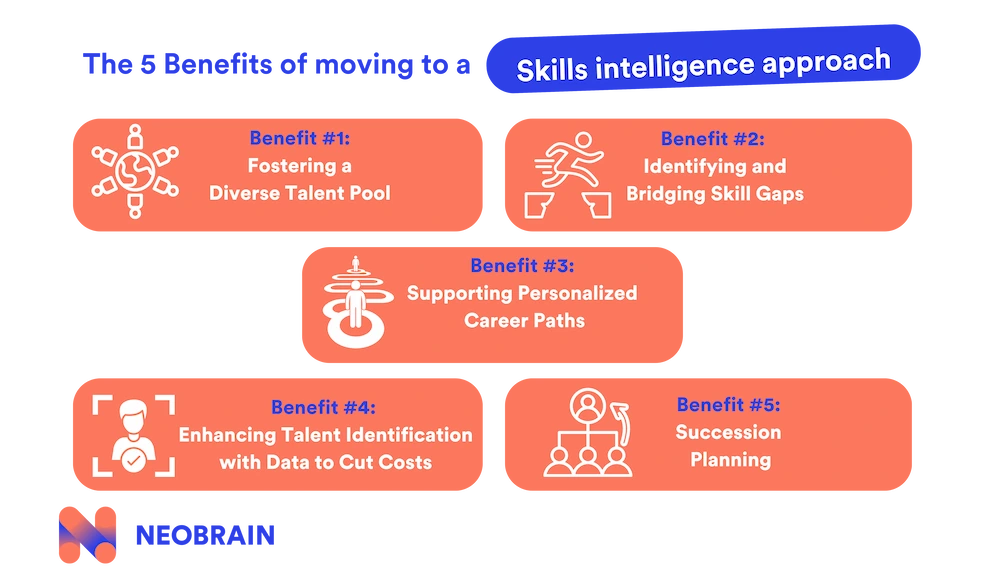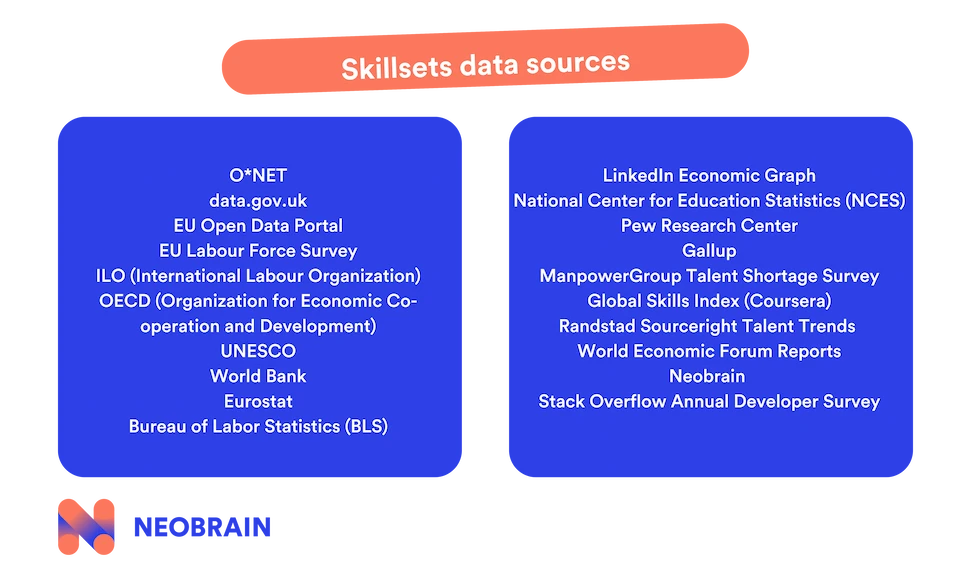At the end of the 1990s, in the midst of the “war for talent“, companies’ main HR focus when dealing with skills was on acquiring external talent. This dynamic changed with the economic expansion of the mid-2000s, which increased employee turnover and tested their loyalty to their organizations.
As a result, from an HR information perspective, talent acquisition data has benefited from greater investment than knowledge of the existing workforce, as evidenced by the success of Linkedin Recruiter, for example. However, the recent economic downturn has changed priorities, underlining the importance of optimizing the existing workforce.
This change marks the reinforcement of what is known as the “ skills approach“, an approach that exploits both external and internal data to look at resources as a whole and make the most of every opportunity. This data-driven approach enables organizations to identify, acquire and mobilize critical skills ,thus ensuring their adaptation to future challenges.
With a new focus on internal resources, a form of intelligence associated with skills management is reconfiguring the levers of competitiveness. This article explores what this approach means for companies seeking to improve performance, its benefits, and how adopting it can lead to significant efficiencies.
What do we mean by “Skills Intelligence”?
The skills approach equips companies with the tools, processes and reflexes to understand and adapt effectively to the demands of their competitive sectors. It plays a crucial role in identifying the skills necessary for individual and organizational success, focusing on meeting current needs and anticipating future ones. By bridging the gaps of skills and maintaining continuous alignment with market developments, this approach is an ally of strategic planning.
At the heart of this approach are three key components:
- Skills inventory: An up-to-date library of skills, degrees, professional experience, certifications and training for an organization’s workforce. This comprehensive inventory tracks current capabilities and highlights areas for development, ensuring that employees’ skills remain relevant and competitive.
- Skills ontology: More than just a classification, a skills ontology provides in-depth analysis by mapping the relationships between various skills in professional contexts. This structured framework enables organizations to effectively navigate the complexity of HR development, supporting smarter, more proactive talent management decisions.
- Data quality enhanced by AI: By harnessing advanced technologies, and AI in particular, this framework enables companies to make informed decisions. This culture therefore requires a foundation of reliable HR data, fed by information systems that communicate easily with each other. For example, performance appraisals or annual reviews need to be connected to the skills management system in order to explain and influence results.
What are the benefits of implementing Skills Intelligence?
This HR approach strengthens workforce diversity, identifies reskilling needs and leads to enhanced performance. It supports personalized career paths, optimizes recruitment costs and contributes to effective succession planning, making organizations more adaptable and resilient.

Benefit #1: Foster a diversified talent pool through Skills-Focused Strategies
Adopting a skills -based approach to workforce planning can significantly eliminate the traditional barriers that often disadvantage under-represented groups.
Focusing on skills rather than on factors such as educational background ensures fairer and more inclusive recruitment decisions.
This method enables a wider and more diverse range of talent to flourish within the organization, leading to a more inclusive working environment for all employees.
Achieving greater diversity through intelligence skills : Case study
A telling example can be seen in one of the leading consulting, auditing, legal and tax firms. Here, generative artificial intelligence was used to explain AI recommendations (in the form of neural networks). Previously, a tendency to reproduce similar candidate profiles had been noted. However, the introduction of Generative AI has enabled a significant diversification of the types of profiles selected.
Results:
The percentage of profiles considered “atypical” rose from 3% to around 15%, demonstrating that AI can radically transform HR practices, making them more inclusive and varied. The combination of traditional AI and generative AI has led to a diversification of the candidates selected.

Benefit #2: Identify and close gaps in skills levels
In the face of rapid technological advances and global economic change, the ability to identify and fill the skills that contribute most to performance is crucial. Exploratory studies diverge on AI’s ability to reshape the labor market, with INSEE in France talking about 5% of Western populations, while the International Monetary Fund or the World Economic Forum suggest 40-60% of jobs by 2025. By leveraging a skills-centric approach, organizations can keep abreast of current and future skills demands, enabling them to respond proactively to the gaps to be filled, and ensure that their workforce is prepared and adaptable.
Focus on closing the skills gaps: Case study
Background :
Leading video game company seeks to understand how AI affects its businesses and skills.
Procedure (synthesis) :
Through a detailed analysis, we identified the specific tasks within the jobs and their relative importance. These tasks were then classified into three groups: exposed, transformed and augmented jobs .
Outcomes:
This classification revealed that 71% of tasks were completed by AI rather than replaced.
Using our data analysis technology at skills, we have identified:
- Exposed jobs(39%)
- Transformed professions(30%)
- More jobs(32%).
We then modeled the transferability of roles from exposed jobs to transformed or augmented jobs, helping employees transition to safer positions for the future.
Find out more about the roadmap you need to adopt to anticipate the impacts of AI on your businesses.
Benefit #3: Reducing silos and supporting personalized career paths
Intelligence applied to skills management transforms traditional hierarchical structures into dynamic talent ecosystems, where skills becomes the internal currency. By adopting workforce planning based on this currency of exchange, companies enable talent to circulate freely across different departments, different divisions of the organization.
At a time when some 60% of American workers are open to the idea of working as freelancers, and the number of freelancers in France has doubled over the past decade, companies are capitalizing on this trend.
This change allows any employee to become a contributor to several internal projects. Offering such short-term assignments should be seen as a performance gas pedal and a key element in improving retention.
Using talent marketplaces for greater cross-functionality: a case study
Many organizations are taking advantage of talent marketplaces whose promise is to align employees’ skills and interests with available opportunities. These platforms take aptitude into account when recommending roles, projects or assignments, encouraging employees to explore new fields and collaborate with diverse teams.
AI is used to analyze sets of skills and suggest various career paths. These career paths are, at Neobrain, presented according to the level of difficulty and capitalization on the skills for which appetence is strongest.
Benefit #4: Improve talent identification with data
By leveraging a skills-based approach, organizations can significantly reduce recruitment expenditure. Intelligent skills management platforms provide detailed insights into the qualifications of existing employees and potential new recruits, enabling accurate talent identification. This targeted approach minimizes the need for external recruitment by optimizing the allocation of internal resources, and ensures that new hires are a perfect match for the role, reducing turnover and associated costs.
Strategic location of Neobrain’s Data Science Hub
Ambition and Context :
Faced with the challenge of recruiting stable, passionate and competent data scientists in Paris due to strong competition and a high turnover rate, Neobrain aimed to identify a new location that could support its growing needs while aligning with its strategic objectives. The objective was not only to find a talent-rich environment, but also to ensure operational efficiency and employee satisfaction.
Selected data sources :
To make an informed decision, Neobrain used a comprehensive set of data sources:
- Labor market analysis: platforms such as LinkedIn Talent Insights and Glassdoor have provided information on the availability and stability of data science talent across Europe.
- Reports on the economic and business environment: Reports from the World Economic Forum and the European Commission have helped to assess economic stability and technological readiness in different regions.
- Cost analysis tools: Payscale and Numbeo were used to compare salary expectations and cost of living, ensuring financial viability.
- Educational institutions: Information on local universities highlighted areas with a constant influx of new graduates.
- Local and governmental development agencies: Local incentives and support programs were examined to find areas offering advantages for technology investment.
- Technology ecosystem reports: The Startup Genome and similar reports have identified dynamic technology communities conducive to innovation.
- Real estate and infrastructure data: Real estate costs and available office space were assessed using local resources and OECD data to ensure suitable and sustainable office locations.
Outcomes:
After extensive analysis, Neobrain chose Lisbon as the ideal location for its new data science hub. The city offered the perfect mix of available talent, a supportive technology ecosystem, a reasonable cost of living and attractive government incentives.
Neobrain has established a 15-strong R&D center in Lisbon, which not only houses data scientists but also supports various roles within the wider Neobrain team. This strategic move has led to a more efficient salary policy and a significant reduction in the turnover rate, keeping it at less than 10%.

Benefit #5: Objective succession planning
Effective succession planning is essential for employee engagement and organizational stability. Although 94% of employers recognize its positive impact, many companies still neglect their leadership pipelines, often opting for external hires due to unclear internal talent assessment criteria. Only 55% of executives feel they fully understand the skills and limitations of their senior managers, revealing significant gaps in succession strategies.
Case study with a leader in the pharmaceutical industry
Background :
A company with 100,000 employees whose high-potential identification process was based more on managers highlighting the best performers than on a truly objective process.
Process:
Neobrain aggregated the results of annual appraisals, performance reviews and profiles of “high-potential” employees to produce “patterns”.
Outcomes:
- Confirmation of 85 of the high potentials already identified – 15% left the panel and new employees entered this closed circle.
- Definition of a list of 10 key indicators for managers to better objectify high potentials
Building a skills-centric organization: 3 key steps
Sometimes companies skip a step in establishing their approach: they acquire workforce planning software even though their HR data is unstructured and unreliable.
We recommend starting by establishing a solid knowledge base in skills through comprehensive workshops and AI technology. Then, empower employees to take charge of evaluating their skills by improving the user experience and understanding their specific needs. Finally, reinforce this change by constantly communicating how skills data has become central to HR decisions and strategic HR management. Konrad Kleinholz presents these recommendations to Ben Eubanks of Lighthouse Research & Advisory in video :
Step 1: Establishing a comprehensive skills framework
Start by conducting an in-depth inventory of skills through workshops in different roles within your organization. This step involves a detailed assessment of job descriptions, performance appraisals and industry standards to identify skills and essential skills. The skills inventory should link each employee’s skills to the requirements of their positions, facilitating the identification of internal candidates for career advancement and critical placements.
Our advice:
This process can be facilitated by integrating AI into the development of a unique ontology to your company. This will save you valuable time upstream of the repository creation process, enabling you to concentrate on workshops with your stakeholders.
Deliverable : The skills Framework
Step 2: Initiating skills-culture change
Implementing a strategy focused on skills often coincides with periods of strategic reassessment, such as changes in business models or new competitive challenges. This phase involves identifying critical pain points where HR needs to actively engage with company stakeholders to understand changing industry demands and opportunities.
Kickstarting the change:
To ensure the success of this skills-centric approach, it is essential to adopt a bottom-up strategy. This meansencouraging employees to take an active part in their own assessments of skillsassessments, thus fostering a sense of ownership and commitment. Such involvement is crucial for accurate mapping of skills and helps HR and business leaders to carry out a comprehensive diagnosis of the company’s strengths and weaknesses.
Deliverable: Mapping of skills
Step 3: Solidifying the Skills-Centric Culture
Now that employees and managers have a clear understanding of their current skills levels, tracking professional growth and defining career goals has become more fluid. This awareness facilitates the creation of customized development plans that directly address identified skills gaps. In addition, training programs are now evaluated and selected according to the skills levels they target, ensuring that each training opportunity is strategically aligned with individual and organizational needs. This holistic approach not only optimizes career development but also maximizes training effectiveness.
Measurable results :
Implementing this skills -centric strategy has produced significant benefits, as Neobrain’s experience shows.
Notable achievements include :
- 30% increase in internal mobility
- 25% reduction in recruitment costs
- 40% improvement in training efficiency
Deliverable: The skills development plan
These results demonstrate the substantial impact of effectively managing and developing skills within the organization, highlighting improvements in terms of cost efficiency and employee advancement.







